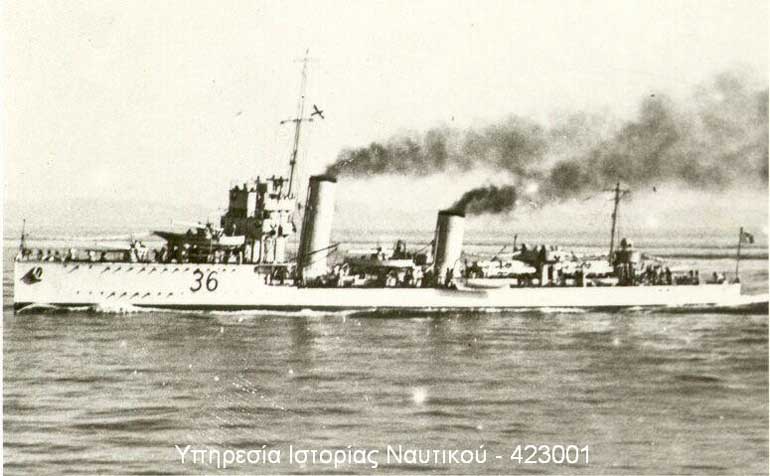.

Ierax, Source: http://www.hellenicnavy.gr/ierax12_46.asp
| Ierax | |
| Career | |
|---|---|
| Ordered: | 1912 |
| Laid down: | 1911 |
| Launched: | March 15, 1911 |
| Commissioned: | 1912 |
| Decommissioned: | 1946 |
| Fate: | broken up |
| Current position: | |
| General Characteristics | |
| Displacement: | standard displacement 880 tonnes tons |
| Length: | 89.4 m |
| Beam: | 8.3 m |
| Draft: | 3 m |
| Speed: | Maximum Speed 31 kts., 32 after 1925 knots |
| Complement: | 58 |
| Armament: | (1912) 4 Bethlehem 10.2 cm guns, one 75 mm A/A gun, six 21 inch T/T and 3 electric search lights.In 1925 the 75 mm gun was removed and a 37 mm A/A gun was installed, along with a four barrel 40 mm gun and 2 mortars.She was modified for laying 40 mines.In 1942 the 3rd and 4th guns of the stern torpedo tubes were removed and one 3-inch A/A gun, one 20 mm Oerlikon gun and an A/S type 123A detection device were added. |
| Powerplant: | Foster Wheeler 4 coal burning and 1 fuel boiler, 5 funnels combined Parsons and Curtis turbines.In 1925 they were replaced by a Yarrow oil fired ones. |
| Armour: | unknown |
Ierax (Greek: Α/Τ Ίεραξ "Hawk") served in the Hellenic Royal Navy from 1912 - 1946.
The ship, along with her three sister ships of Wild Beast Class destroyers Aetos, Panthir and Leon, was ordered from England. They were purchased ready for delivery, each for the sum of 148,000 pounds, from the English shipyards Camell Laird in Liverpool, when the Balkan Wars seemed likely. These ships had originally been ordered by Argentina; Ierax was originally named Santa Fé. Accepted by Captain Ath. Miaoulis, RHN in Palermo, Sicily. where she arrived manned by foreign crew.
During the Balkan Wars, only the essential ammunitions were purchased (3,000 rounds). Torpedoes were not available and for this reason these ships were initially named 'scouts' rather than 'destroyers'. On October 21, 1912, under the command of Commander A. Vratsanos, RHN, Ierax was part of the Greek flotilla that captured the island of Psara from the Ottomans.[1]
During World War I, Greece belatedly entered the war on the side of the Triple Entente and, due to Greece's neutrality the four Beast Class ships were seized by the Allies in October, 1916, taken over by the French in November and served in the French Navy from 1917-18. By 1918, they were back on escort duty under Greek colors, mainly in the Aegean Sea.
Ierax participated in the evacuation of Greeks from Russia during the Russian Revolution in 1918, and saw action in the Greco-Turkish War (1919-1922) in the Sea of Marmara and the Aegean Sea.
After the war, Ierax was refurbished from 1925-1927. She also participated in the Second World War, after surviving the German invasion of April, 1941, Ierax was based in Alexandria, Egypt. In April, 1944, a wave of mutiny swept through some of the Hellenic Royal Navy, with seamen agitating in favor of the pro-Communist guerillas, ELAS, who were fighting a campaign in Greece against the occupying Nazis. Ierax was one of the ships whose crew mutinied and the mutiny was put down in the early morning hours of April 22, 1944.[2]
After the end of World War II, Ierax was stricken in 1946.
References
- ^ http://www.hellenicnavy.gr/ierax12_46_en.asp
- ^ Vice Admiral G. Mezeviris, "Four Decades in the Service of the Royal Hellenic Navy", Athens, 1971.
See also
| Ancient Greece
Science, Technology , Medicine , Warfare, , Biographies , Life , Cities/Places/Maps , Arts , Literature , Philosophy ,Olympics, Mythology , History , Images Medieval Greece / Byzantine Empire Science, Technology, Arts, , Warfare , Literature, Biographies, Icons, History Modern Greece Cities, Islands, Regions, Fauna/Flora ,Biographies , History , Warfare, Science/Technology, Literature, Music , Arts , Film/Actors , Sport , Fashion --- |
Retrieved from "http://en.wikipedia.org/"
All text is available under the terms of the GNU Free Documentation License

